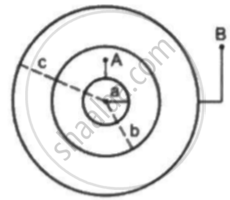Advertisements
Advertisements
Question
Can the potential function have a maximum or minimum in free space?
Solution
No, the potential function does not have a maximum or minimum in free space, it is because the absence of atmosphere around the conductor prevents the phenomenon of electric discharge or potential leakage.
APPEARS IN
RELATED QUESTIONS
Define capacitor reactance. Write its S.I units.
Take `C_1 = 4.0 "uF" and C_2 = 6.0 "uF"` in figure . Calculate the equivalent capacitance of the combination between the points indicated.

Find the equivalent capacitance of the system shown in figure between the points a and b.

Suppose the space between the two inner shells is filled with a dielectric of dielectric constant K. Find the capacitance of the system between A and B.

Three capacitors C1 = 3μF, C2 = 6μF, and C3 = 10μF are connected to a 50 V battery as shown in Figure below:

Calculate:
(i) The equivalent capacitance of the circuit between points A and B.
(ii) The charge on C1.
Obtain an expression for equivalent capacitance when three capacitors C1, C2 and C3 are connected in series.
Three capacitors are connected in a triangle as shown in the figure. The equivalent capacitance between points A and C is ______.

The positive terminal of 12 V battery is connected to the ground. Then the negative terminal will be at ______.
A parallel plate capacitor is filled by a dielectric whose relative permittivity varies with the applied voltage (U) as ε = αU where α = 2V–1. A similar capacitor with no dielectric is charged to U0 = 78V. It is then connected to the uncharged capacitor with the dielectric. Find the final voltage on the capacitors.
For changing the capacitance of a given parallel plate capacitor, a dielectric material of dielectric constant K is used, which has the same area as the plates of the capacitor.
The thickness of the dielectric slab is `3/4`d, where 'd' is the separation between the plate of the parallel plate capacitor.
The new capacitance (C') in terms of the original capacitance (C0) is given by the following relation:
